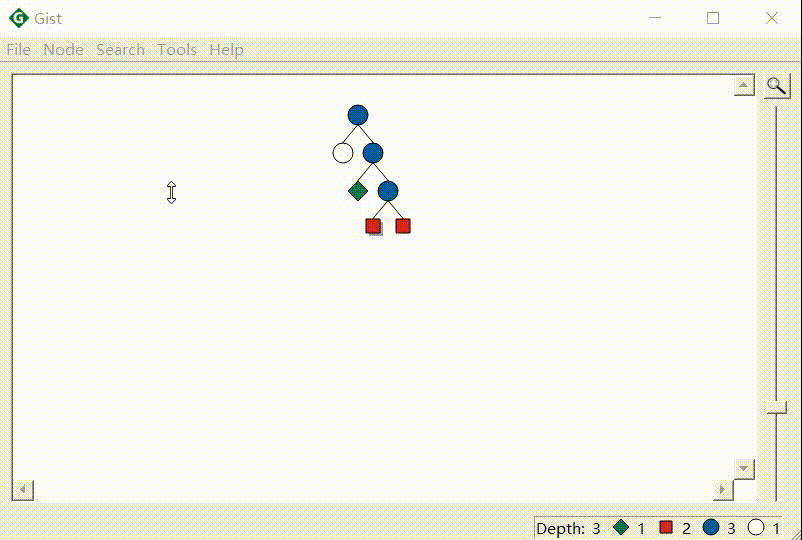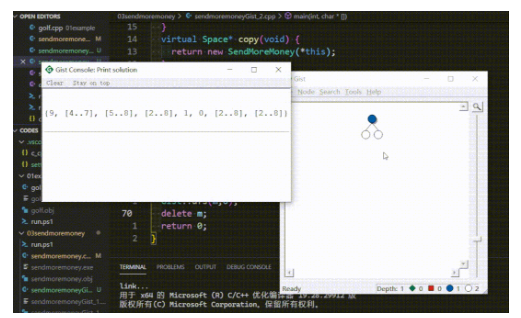前言:这是我 3月22日 写的线性求解器 gecode 的笔记。我喜欢 gecode 的文档,也很喜欢它简洁流畅的 C++ 源码。计划赶不上变化快,当时兴致勃勃的我,真的想不到,3月22日是我这五个月来最后一次写这么工整的笔记;之后我便陷入一场极大的拉锯战中——无暇再打开这个笔记(甚至都给忘了,这几天整理资料才想起),但拉锯战最终收获甚少;当时的我更想不到,现在提起「线性优化」这个课题,我的第一反应是拒绝。我很喜欢这个笔记,稍微阅读我便可以把当时总结的重点全部回顾起来。这几个月来的教训是:不要认为自己可以什么都学、什么都涉猎,赶快定好一个细分方向,努力下去吧。接下来的很长一段时间,我可能都没空更新这个笔记了。我当时的期望「gecode 是很优秀的线性求解器,但中文互联网几乎没有其系统性教辅资料,我用研一下学期来写一套」近期也不可能实现了。共勉。我会回来看你的,老伙计。
Gecode基础知识
- Gecode基础知识[1]
- SendMoreMoney[3]
- 必须注意的点[4]
- rel - 关系约束[5]
- distinct - 两两不同约束[6]
- branch - 定义分支规则[7]
- 关于 print[8]
- 以SendMoreMoney为例[2]
- 搜索引擎的使用[9]
- 异常处理[10]
- Gist - 可视化求解过程[11]
- 设定目标值[12]
- 笔记地址[13]
以SendMoreMoney为例
SendMoreMoney
我们给这八个字母赋值(赋一个数字):S E N D M O R Y
使得等式成立:SEND + MORE = MONEY ,其中每个字母是不同的数字。
还不明白?告诉你答案,我们最后要把 SEND + MORE = MONEY 替换为 9567 + 1085 = 10652 。这就是求解成功了,其中 S 是 9 、 E 是 5 ...
必须注意的点
代码在:https://gitee.com/piperliu/math_codes_economics_management/tree/master/gecode_MPG_notes/codes/03sendmoremoney/sendmoremoney.cpp[14]
- // 使用整数变量和整数约束
- // 我们需要 include gecode/int.hh 头文件
- #include <gecode/int.hh>
- // 使用搜索引擎(求解逻辑),我们需要 gecode/search.hh 头文件
- #include <gecode/search.hh>
- // 所有的 gecode 功能都在命名空间 Gecode 里
- // 所以,避免 Gecode::IntVarArray 这样的麻烦
- // 我们 using namespace Gecode; 来简化代码
- using namespace Gecode;
- // 所有的模型都要继承 Gecode::Space
- class SendMoreMoney : public Space {
- protected:
- // 这里声明了一个整数变量数组 l
- IntVarArray l;
- public:
- // 在构造函数里声明模型
- // l(*this, 8, 0, 9) 表示:
- // - 变量数组 l 是这个模型的(this)
- // - 变量数组 l 包含 8 个变量
- // - 这些变量的取值范围是 [0, 9]
- SendMoreMoney(void) : l(*this, 8, 0, 9) {
- // 我们声明了一些变量
- IntVar s(l[0]), e(l[1]), n(l[2]), d(l[3]),
- m(l[4]), o(l[5]), r(l[6]), y(l[7]);
- // 下面是一些约束的实现,先不用管具体含义
- // no leading zeros
- rel(*this, s, IRT_NQ, 0);
- rel(*this, m, IRT_NQ, 0);
- // all letters distinct
- distinct(*this, l);
- // linear equation
- // 这里是一些 Args 变量
- // 我把 Var 理解为决策变量,或者自变量
- // 而 Args 是根据 Var 变动的,中介变量
- // 本身并不主动变化,受 Var 们变动影响
- IntArgs c(4+4+5); IntVarArgs x(4+4+5);
- c[0]=1000; c[1]=100; c[2]=10; c[3]=1;
- x[0]=s; x[1]=e; x[2]=n; x[3]=d;
- c[4]=1000; c[5]=100; c[6]=10; c[7]=1;
- x[4]=m; x[5]=o; x[6]=r; x[7]=e;
- c[8]=-10000; c[9]=-1000; c[10]=-100; c[11]=-10; c[12]=-1;
- x[8]=m; x[9]=o; x[10]=n; x[11]=e; x[12]=y;
- linear(*this, c, x, IRT_EQ, 0);
- // 定义了分支定界的规则
- // post branching
- branch(*this, l, INT_VAR_SIZE_MIN(), INT_VAL_MIN());
- }
- // 必须声明一个 copy constructor
- // 其中一定一定要有对于变量的更新
- // search support
- SendMoreMoney(SendMoreMoney& s) : Space(s) {
- l.update(*this, s.l);
- }
- // 以及声明一个 copy 方法(用于search)
- virtual Space* copy(void) {
- return new SendMoreMoney(*this);
- }
- // print solution
- void print(void) const {
- std::cout << l << std::endl;
- }
- };
- // main function
- int main(int argc, char* argv[]) {
- // create model and search engine
- SendMoreMoney* m = new SendMoreMoney;
- DFS<SendMoreMoney> e(m);
- delete m;
- // search and print all solutions
- while (SendMoreMoney* s = e.next()) {
- s->print(); delete s;
- }
- return 0;
- }
如上,我们实现了一个问题,我在中文注释中做出了解释。值得注意的有:
- 所有的 gecode 功能都在命名空间 Gecode 里
- 所有的模型都要继承 Gecode::Space
- 除了基本的构造函数,必须声明一个 copy constructor 、以及声明一个 copy 方法(用于search)
- 我们必须在 copy constructor 对决策变量进行更新(比如 l.update(*this, s.l);),这尤为重要,否则程序不会报错,而求解过程是错误的。原因在于,我们的求解器在求解过程中,会不断赋值 Space 实例,如果不在 copy constructor 中更新决策变量,则无法进行回溯、保存等操作
我把 Var 理解为决策变量,或者自变量;而 Args 是根据 Var 变动的,中介变量,本身并不主动变化,受 Var 们变动影响。
注意到无论是变量还是约束,其声明时,第一个参数都 *this 。你可以如此理解:变量如小孩子,小孩子出生,必须明确 ta 的监护人是谁,否则,接下来小孩子没有依靠,这个小孩子也就活不下去。在这里,我们的变量和约束都依靠其存在的问题中,即类 SendMoreMoney 。
rel - 关系约束
- rel(*this, s, IRT_NQ, 0);
上述语句表示:变量 s 不等于 0,其中:
- IRT_NQ 表示不等于,我们将在后文见到所有的逻辑符号表达
- rel 是 relation 的意思
distinct - 两两不同约束
- distinct(*this, l);
我们这里不具体阐述 distinct 的用法,只说明其作用:
- l 数组中变量要两两不同(pairwise different)
其他约束不再详述,以后会提到。
branch - 定义分支规则
在求解过程中,不同的搜索方式对于求解效果有着天差地别的影响。因此定义合适的 branch 分支规则尤为重要。
- branch(*this, l, INT_VAR_SIZE_MIN(), INT_VAL_MIN());
这里表示,对于变量数组 l 中的变量,我们首先选择对其中搜索范围最小的变量进行搜索(INT_VAR_SIZE_MIN()),此外如果选择了一个变量,我们将现有的最小值赋给它(INT_VAL_MIN())。
其他规则以及关于 branch 的用法将在后文讨论。
关于 print
在求解后, gecode 会自动调用 print 输出。我们可以自由发挥,重载 print 函数,让解是我想要的形式。
- // print solution
- void print(void) const {
- std::cout << l << std::endl;
- }
求解后的效果:
- {9, 5, 6, 7, 1, 0, 8, 2}
表示 S 是 9 、 E 是 5 ...
搜索引擎的使用
我们在上面定义了我们的问题(包含变量与约束),我们在程序中称之为一个“模型model”。
这个模型对象中存储了当前变量的范围,我将其理解为搜索中的一些节点的集合(在一些运算后产生的更小的、更精准的解空间)。
那么如何实现一颗搜索树呢?在 main 方法中,我们将其实现。
- // main function
- int main(int argc, char* argv[]) {
- // create model and search engine
- SendMoreMoney* m = new SendMoreMoney;
- // 第一个 print()
- std::cout << "1" << std::endl;
- m->print();
- m->status();
- // 第二个 print()
- std::cout << "2" << std::endl;
- m->print();
- DFS<SendMoreMoney> e(m);
- // 第三个 print()
- std::cout << "3" << std::endl;
- m->print();
- delete m;
- // search and print all solutions
- while (SendMoreMoney* s = e.next()) {
- // 第四个 print()
- std::cout << "4" << std::endl;
- s->print(); delete s;
- }
- return 0;
- }
你可以看到,我在上面安插了 4 个 print,来看看当前我们搜索到的范围。输入如下。
- 1
- {[1..9], [0..9], [0..9], [0..9], [1..9], [0..9], [0..9], [0..9]}
- 2
- {9, [4..7], [5..8], [2..8], 1, 0, [2..8], [2..8]}
- 3
- {9, [4..7], [5..8], [2..8], 1, 0, [2..8], [2..8]}
- 4
- {9, 5, 6, 7, 1, 0, 8, 2}
当我们声明这个问题时(初始化模型),我们的模型根据约束做了一些最基本的运算,在这里体现为:
- S的范围应该是[1, 9]
- M的范围应该是[1, 9]
这很好理解,因为我们有约束 rel(*this, s, IRT_NQ, 0);, rel(*this, m, IRT_NQ, 0); 。
只有当我们调用 status() 后,约束传播constraint propagation才会起作用。
status函数的注释原文为 Query space status Propagates the space until fixpoint or failure; updates the statistics information stat; and:
- if the space is failed, SpaceStatus::SS_FAILED is returned.
- if the space is not failed but the space has no brancher left, SpaceStatus::SS_SOLVED is returned.
- otherwise, SpaceStatus::SS_BRANCH is returned.
我的理解是,对现有的解空间做一次最基本的探索,直到需要 branch 做决策的点或者探索失败。
值得注意的是,如果我们取消上述 m->status(); 这句话,那么 3 对应的 print() 依然是 {9, [4..7], [5..8], [2..8], 1, 0, [2..8], [2..8]} 。这说明为我们的模型声明搜索引擎时,会调用一次 status() 。
如下,在 while 中,我们希望返回每一次探索的解。值得注意的是,解也是一个模型(问题实例)。
- while (SendMoreMoney* s = e.next()) {
- // 第四个 print()
- std::cout << "4" << std::endl;
- s->print(); delete s;
- }
在这里,e是基于DFS深度优先搜索的搜索引擎,e.next()则是基于DFS规则做出的下一个探索方向的探索结果。如果探索到头了,那么e.next()会返回NULL,此时 while 停止,跳出循环。
异常处理
实际上,为了捕捉 Gecode 的异常,使用 try {} catch () {} 是一个很好的选择。
- int main(int argc, char* argv[]) {
- try {
- // main 中的内容
- } catch (Exception e) {
- std::cerr << "Gecode exception: " << e.what() << std::endl;
- return 1;
- }
- return 0;
- }
注意,这里的 Exception 是 Gecode 命名空间中的异常Gecode::Exception。
不管是本笔记还是教程文件MPG,都没有使用 try catch (为了易读性),但是在时间使用中,还是应该具有如此的良好习惯。
Gist - 可视化求解过程
程序见https://gitee.com/piperliu/math_codes_economics_management/tree/master/gecode_MPG_notes/codes/03sendmoremoney/sendmoremoneyGist_1.cpp[15]
- #include <gecode/gist.hh>
- using namespace Gecode;
- ...
- int main(int argc, char* argv[]) {
- SendMoreMoney* m = new SendMoreMoney;
- Gist::dfs(m);
- delete m;
- return 0;
- }
我们引入 gist.hh 头文件,在 main 中较为简单地可视化 dfs 过程。
可以用鼠标探索
关于 gist 功能,还有其他调用方法。gist功能较为强大,这里不再赘述。
此外,还可用手动增加现实解的功能,代码见https://gitee.com/piperliu/math_codes_economics_management/tree/master/gecode_MPG_notes/codes/03sendmoremoney/sendmoremoneyGist_2.cpp[16]
添加了 inspect
设定目标值
设定目标值时,我们需要声明 cost 函数以及用变量表示搜索过程中变量的传递(用于目标函数的计算)。这里不详细讨论。
这并不复杂,我们将在之后的笔记中专门讨论。



































